This year started badly for Liverpool. Two consecutive away defeats against second-placed Manchester City and Wolverhampton, in the Premier League and FA Cup respectively, definitely shook Jurgen Klopp’s men confidence for a bit. However, the current league leaders reacted very well by securing a 1-0 win away at Brighton in the previous gameweek, thus proving they are still worthy of their position.
Crystal Palace came into this match with little hope after a disappointing 2-1 home defeat to Watford. Roy Hodgson’s men weren’t on good form either, having previously only won by a one goal margin over League Two side Grimsby County in the FA Cup. Despite their mediocre performances however, Palace were able to defeat title-challenger Manchester City at the Etihad just before Christmas, proving that they are still a dangerous side to face for any team.
The match turned out to be brilliant. A thrilling encounter produced everything: seven goals, a blunder, a red card, late drama, you name it. Hodgson’s ultra-defensive approach effectively reduced Liverpool‘s attacking threats for most of the game, while their rapid attackers disrupted the home side’ defensive department with deadly counter-attacks. At the end of the day, Klopp’ side came out victorious. Credit must go to their patience, individual brilliance, and some luck. This piece will give you a detailed analysis of how the game unfolded.
Starting XI
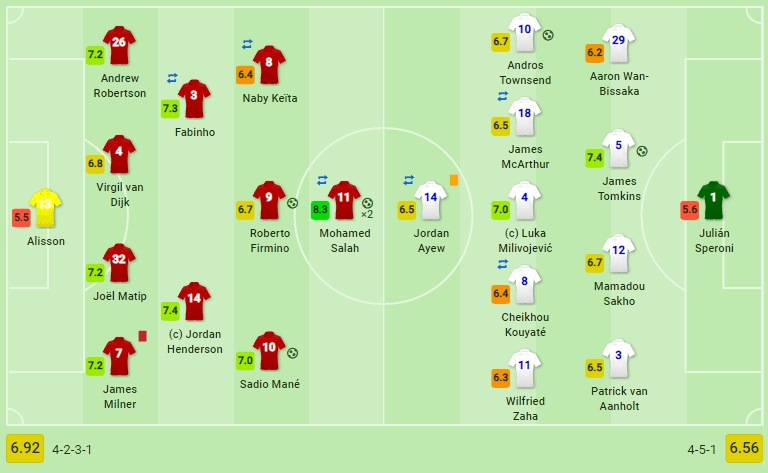
Liverpool used 4–2–3–1 for this game with some changes to the lineup. Former Schalke defender Joel Matip returned to the starting XI ahead of Dejan Lovren and Joe Gomez to partner Virgil van Dijk. Jordan Henderson and Fabinho provided balance as holding midfielders in front of them. One little surprise was Sadio Mane’ placement as a right winger, while Naby Keita took the Senegalese’ favourite spot on the left wing.
Veteran goalkeeper Julian Speroni made his first start since December 2017 for the away side as a result of Wayne Hennessey’s injury. A midfield trio of James McArthur, Luka Milivojevic and Cheikhou Kouyate supplied solid defensive cover for the back four. Wilfried Zaha and Andros Townsend provided the width on the flanks while Jordan Ayew acted as a lone striker up front.
Crystal Palace park the bus
From the start, Palace opted to sit deep in a low block using 4–5–1. In that formation, the defenders were very close to each other in order to prevent the opponent’ attackers from attacking the channels. Meanwhile, in the midfield, five men provided solid cover for the defensive department.
Palace’s 4-5-1 formation was very compact, horizontally and vertically, and closed any gap between the lines. This prevented Liverpool building from the centre and forced them to use the width of the pitch.
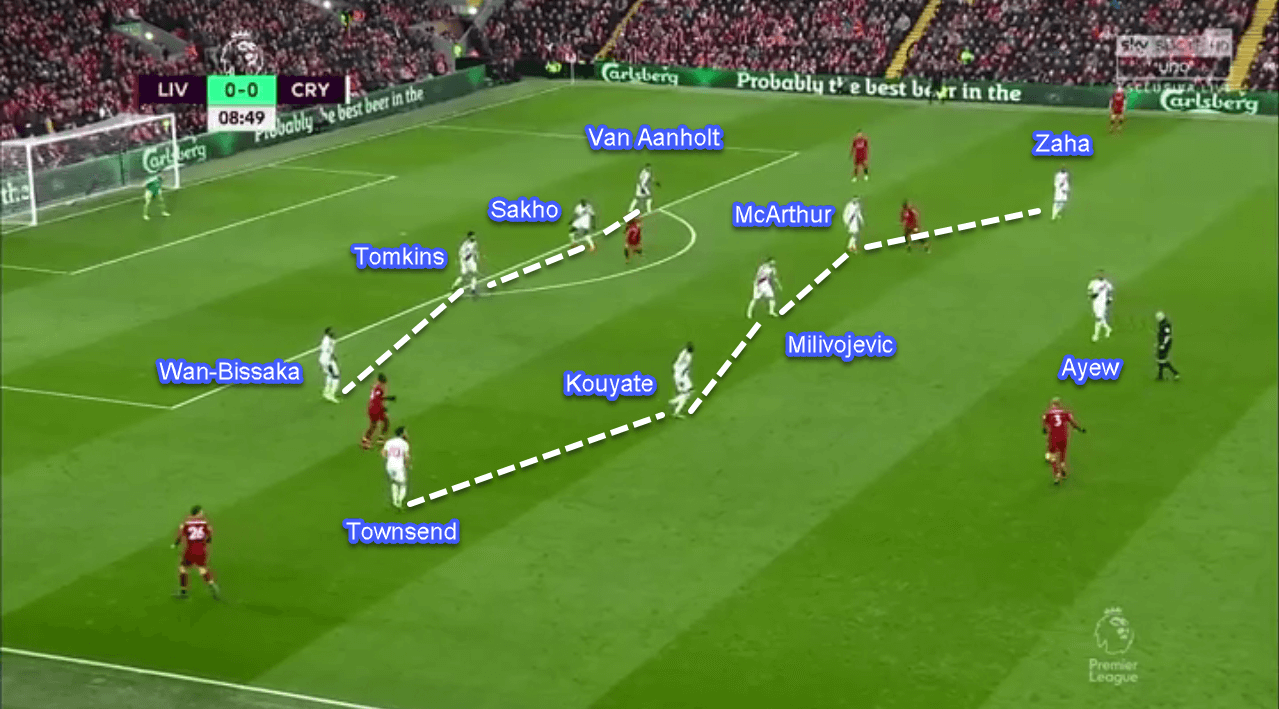
Liverpool’s attackers rarely got the ball in between the lines. Even if they eventually received the ball there, the visiting defenders would easily cut off every possible passing lane and combination option. Hodgson’s choice to put bodies in front of the penalty box proved effective since they successfully limited Liverpool’s attacking threats forlarge periods.
The Reds’ forwards were frustrated because they couldn’t penetrate Palace’ packed defence. Keita, Mane, and Roberto Firmino often rotated their positions in order to disorganise Palace’ shape. They would also happily drop into midfield so they could receive the ball and help the distribution. Liverpool’s main striker, Mohamed Salah, sometimes also dropped out of his position to create attacks from deeper areas.
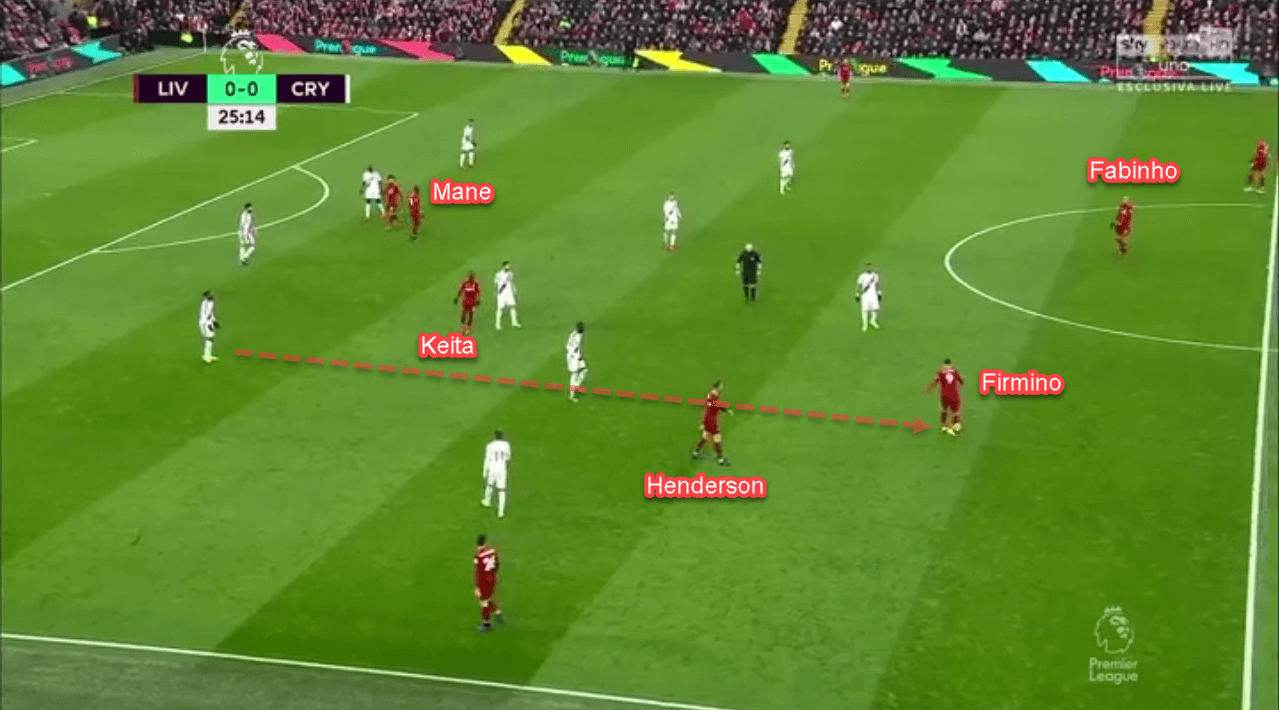
Liverpool wing play
Palace’s 4–5–1 possessed some issues, especially on the flanks. Their four defenders were very close to each other so they could close the central part of the pitch. This left both flanks left empty. Aaron Wan-Bissaka and Patrick van Aanholt were focused on following Liverpool’s wingers, Mane and Keita, who preferred to stay inside rather than drifting wide. On top of that, a lack of defensive cover from Townsend and Zaha allowed those gaps to be exploited.
Noticing there were available gaps to exploit, Klopp allowed both of his full-backs to bomb forward. Both James Milner and Andrew Robertson were very aggressive and they would happily make overlaps down their respective flanks. Usually, one of the midfielders would try to find them with a diagonal pass over the top into the empty space.
Once they received the pass, they would quickly try to cross into the box. Unluckily for Liverpool, the visitors’ defenders were physically stronger and very good in the air. Putting crosses into the penalty area created almost zero results.
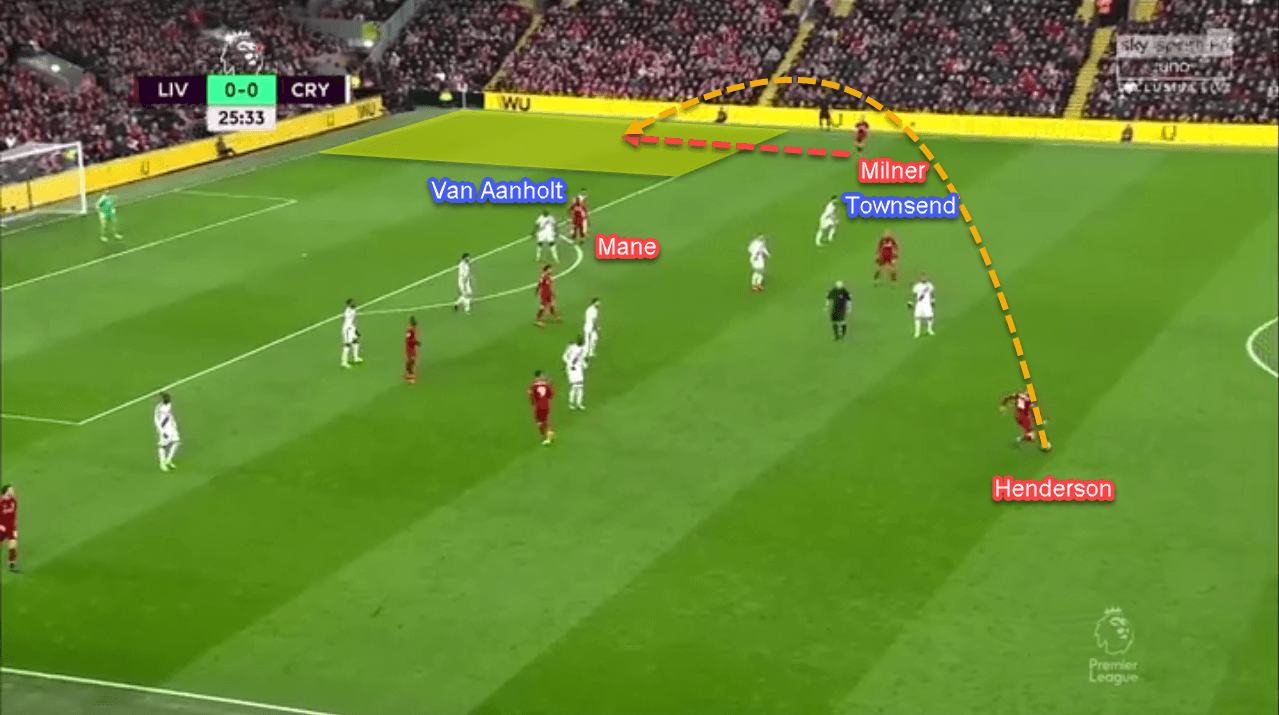
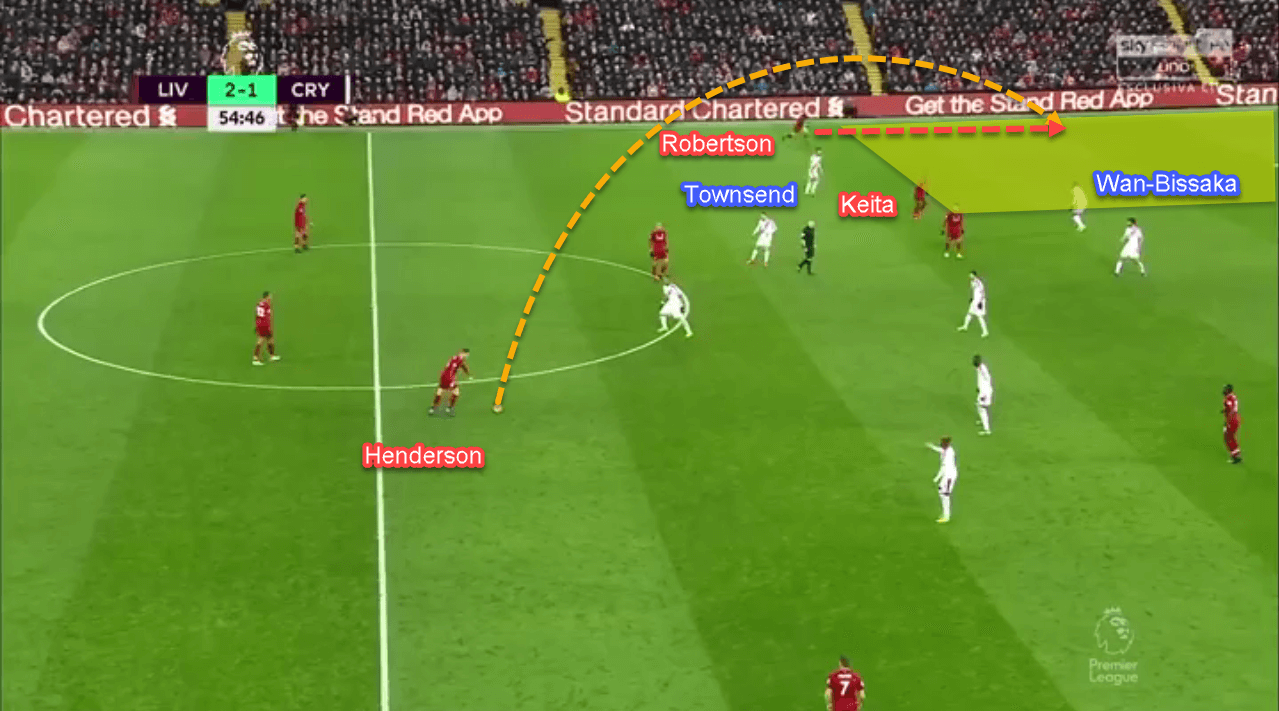
In the opening 20 minutes of the game, Liverpool commanded complete control of the ball, but didn’t truly control the game. Despite having the ball for the opening part of the game, they made no dangerous chances. Their combination options were cut off, their wing plays made no impact, and they often found themselves frustrated facing the away side’s low block.
It was clear to see that Hodgson’s defensive plan worked brilliantly. His team defended in a well-coordinated fashion and successfully contained the deadly front four of Liverpool for most of the first half. The back four was very sound and disciplined, thus frustrating the league leaders.
Surprise, surprise
Due to their defensive approach in this game, Palace opted to attack Liverpool with rapid counter-attacks. Utilising the pace and dribbling ability of Zaha, Townsend and Ayew, Palace tried to make their best effort in transitional attacks.
In the opening 30 minutes, however, the trio rarely got the chance to penetrate Liverpool’s defence. This happened mainly because of the lack of quality passes they got from the back. Another reason was the huge distance the attackers had to face (at least 60 yards from their standing position to Liverpool’ penalty box) that limited their explosiveness in counter-attacks.
After the half-hour mark, Palace were able to gain some solid minutes in possession. Their counter-attacking quality also improved because of that. In the 34th minute, Anfield was silenced. An explosive counter-attack through the right-hand side of Liverpool’s defence ended in a goal for the away side via a cool finish from Townsend.
The goal basically started a minute before, when The Eagles were casually trying to build their attack from their defenders. Palace had already sent bodies forward, leaving only James Tomkins, Mamadou Sakho, and McArthur in the first phase of their attack. Liverpool’s attackers were aware of this and were ready to make their coordinated pressing.
Somehow McArthur, who was on the ball, escaped the pressure from Keita and Firmino, and returned the ball to Tomkins. The centre-back was very calm and also successfully evaded pressure from Keita and Mane before passing the ball forward to the dropping Milivojevic.
Henderson and Robertson were already making their runs to join the press. The Serbian then laid the ball back to McArthur with his first touch. The latter then switched the play to Van Aanholt, eliminating six Liverpool players in the process.
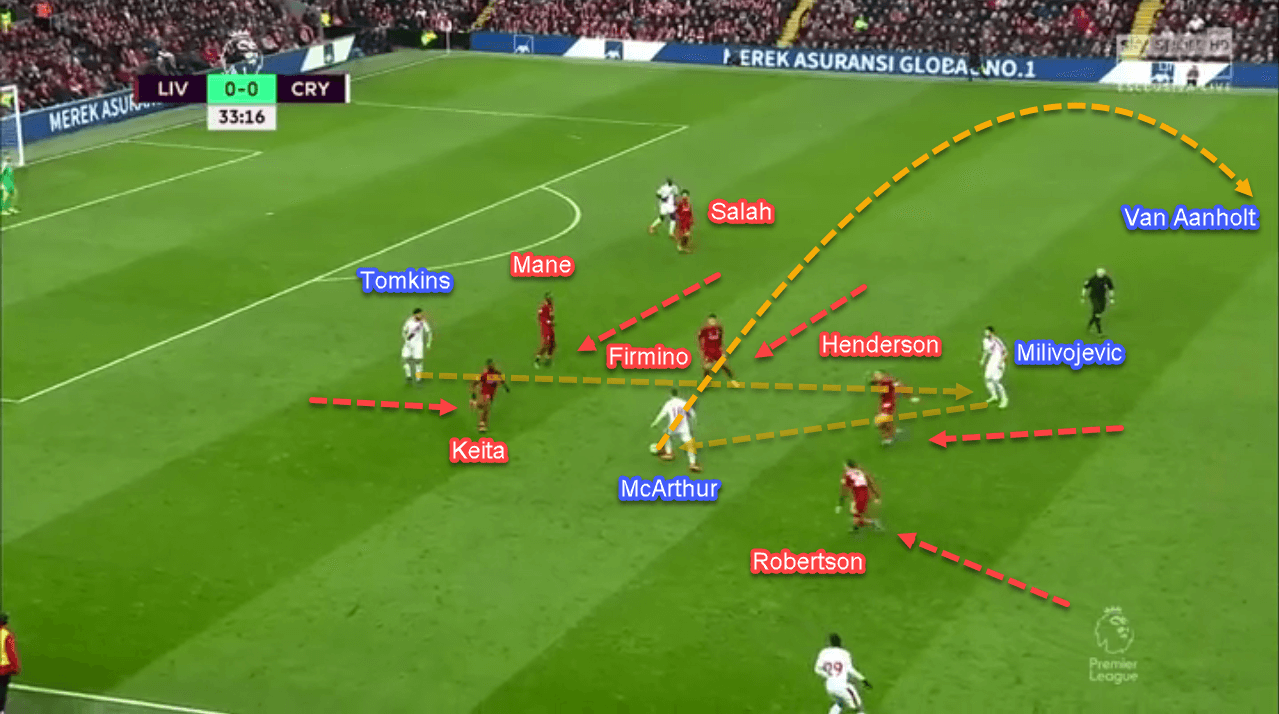
Van Aanholt quickly bombed forward and found Zaha free on the left wing. Zaha then easily beat Milner in one-on-one duel before cutting the ball back to the incoming Townsend. The former Spurs attacker then scored past Alisson with his first touch to give his team the lead.
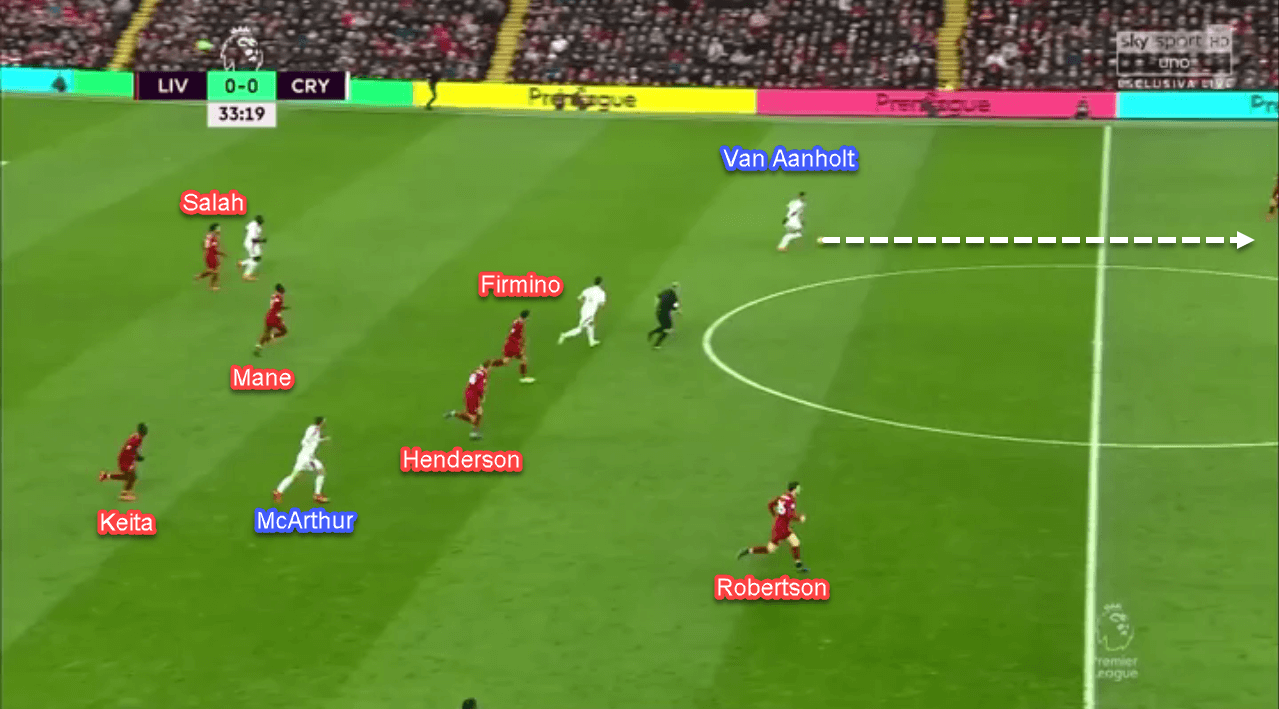
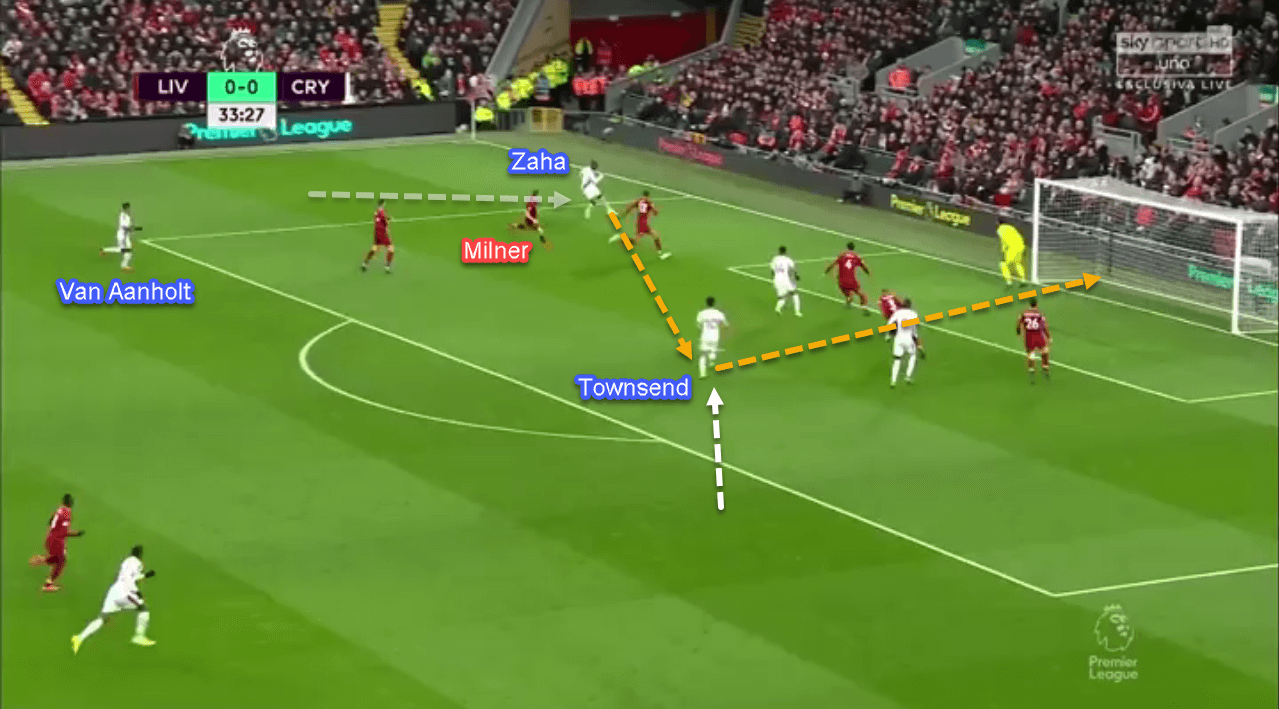
Lucky Liverpool? (Part one)
Fifty-six seconds into the second half, Liverpool got their equaliser. Van Dijk’s hopeful long shot hit McArthur’ body. The ball somehow ended in Salah’s path, who finished smartly with his genius first touch. Speroni, trapped in no man’s land because of the heavy deflection, was unable to respond. Game on.
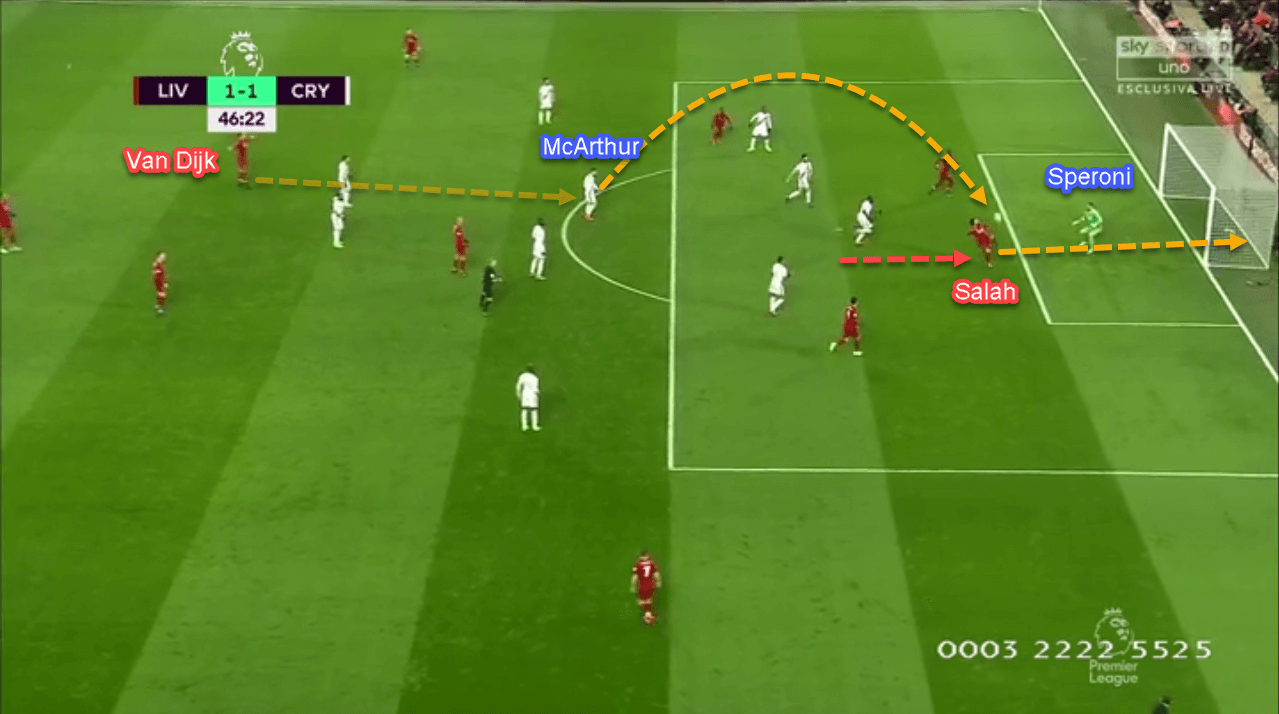
About seven minutes later, Liverpool got their second goal via Firmino. The goal started with a failed corner kick attempt by Liverpool on the left-hand side of Palace’s defence. The ball then moved to the opposite side.
Firmino, who smartly placed himself in a pocket of space inside Palace’ penalty box, received a short pass from Keita. The Brazilian had nobody around him and received the ball comfortably, before sublimely slotting the ball (with a slight deflection from Kouyate) inside the far post seconds later to put his side 2-1 up.
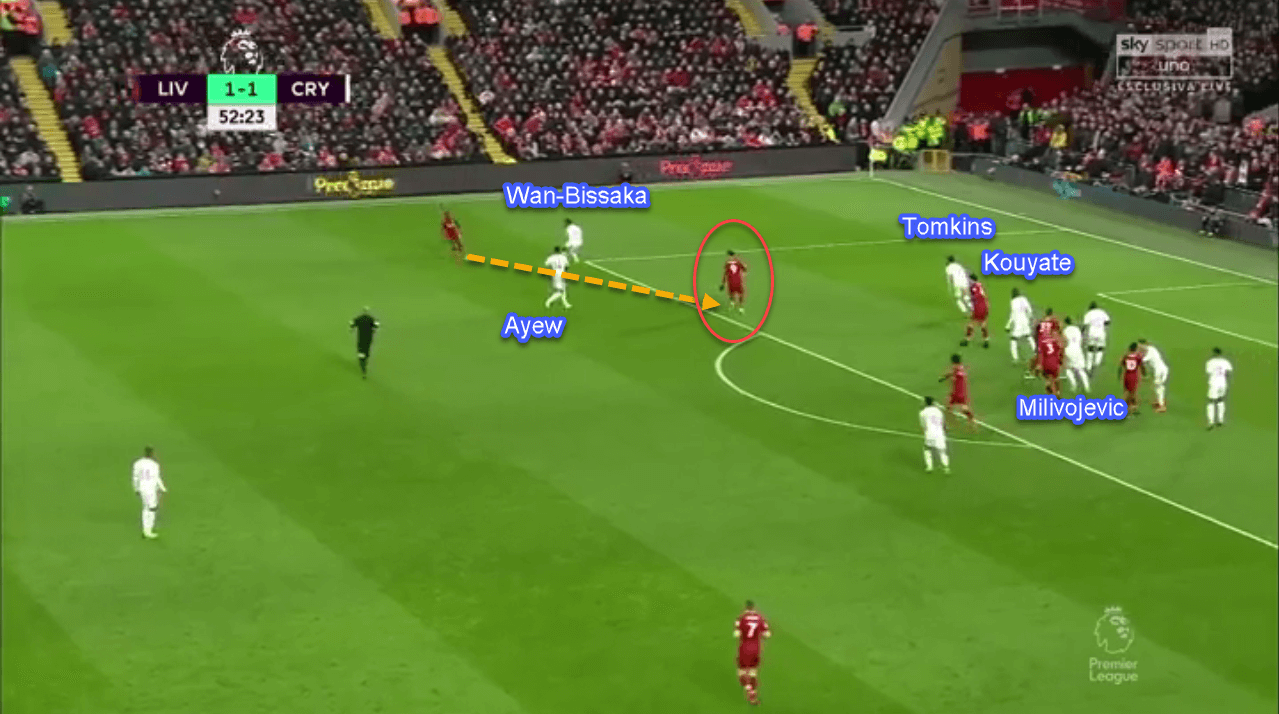
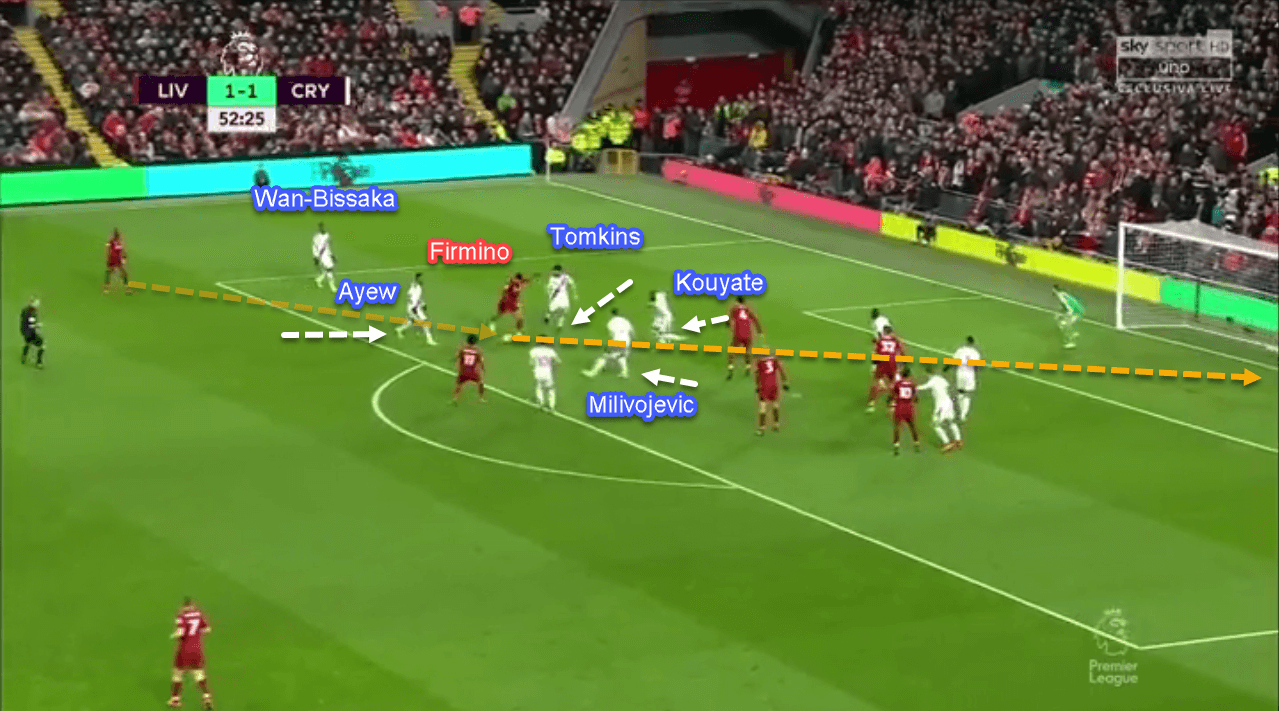
Tomkins to the rescue
Despite being left one goal down, Hodgson maintained his defensive approach. He instructed his team to keep using counter-attacks as their main weapon. Twelve minutes after Firmino’s goal, one counter-attack from the men in white ended in a corner kick. Milivojevic’s pinpoint cross found Tomkins at the far post, who headed home under no pressure whatsoever to equalise again.
In that corner kick routine, Palace used a set-up that a bit similar to what England used in the World Cup last year; the
‘love train‘set-up. In this routine, Tomkins was the main target and placed behind his two team-mates, Kouyate and McArthur. Liverpool were already outnumbered in this sequence because they only placed two men, Henderson and Fabinho, against Palace’ trio. At the far post, Van Dijk marked Ayew tightly.
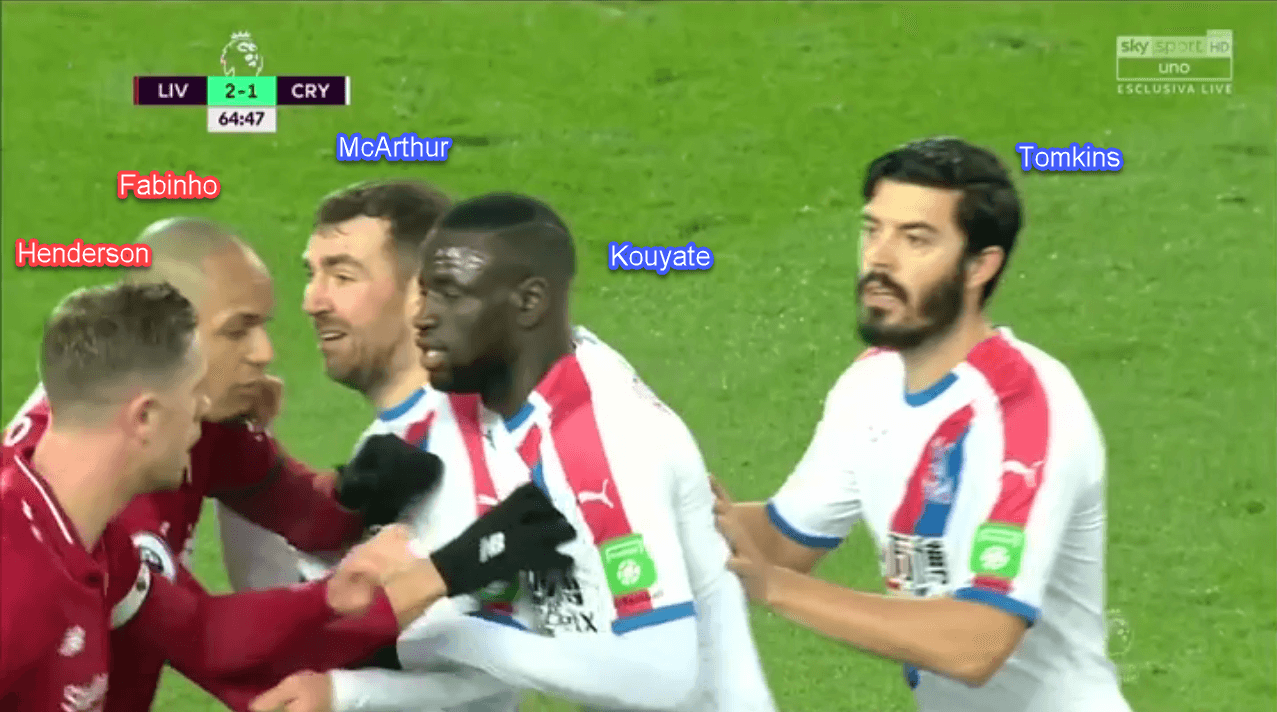
Fabinho was the man tasked with following Tomkins. When the latter moved to the far post, the former Monaco man instantly followed him. What Fabinho didn’t realise was Ayew’s role. The Ghanaian, marked by Van Dijk, acted as a screen in this set-up. If you follow basketball, you will be familiar with this simple function. As a screen, he successfully held both Van Dijk and incoming Fabinho with him, thus leaving Tomkins free at the far post to head the ball home.
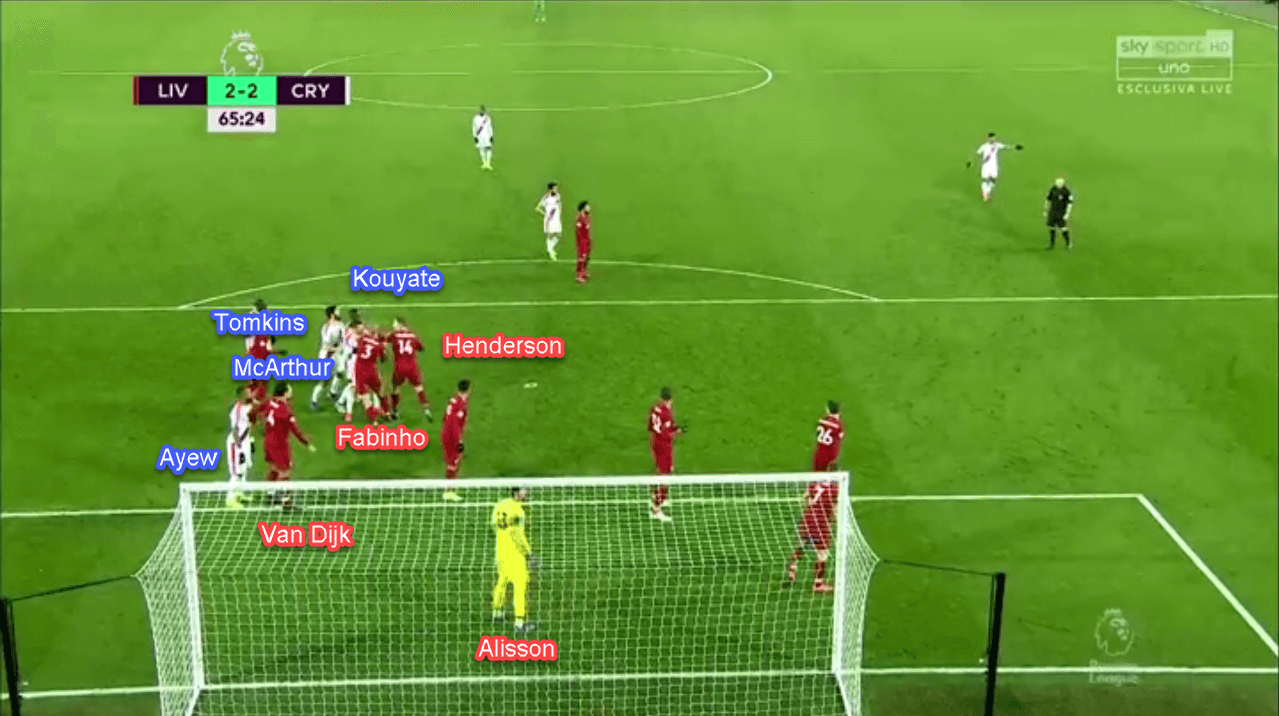
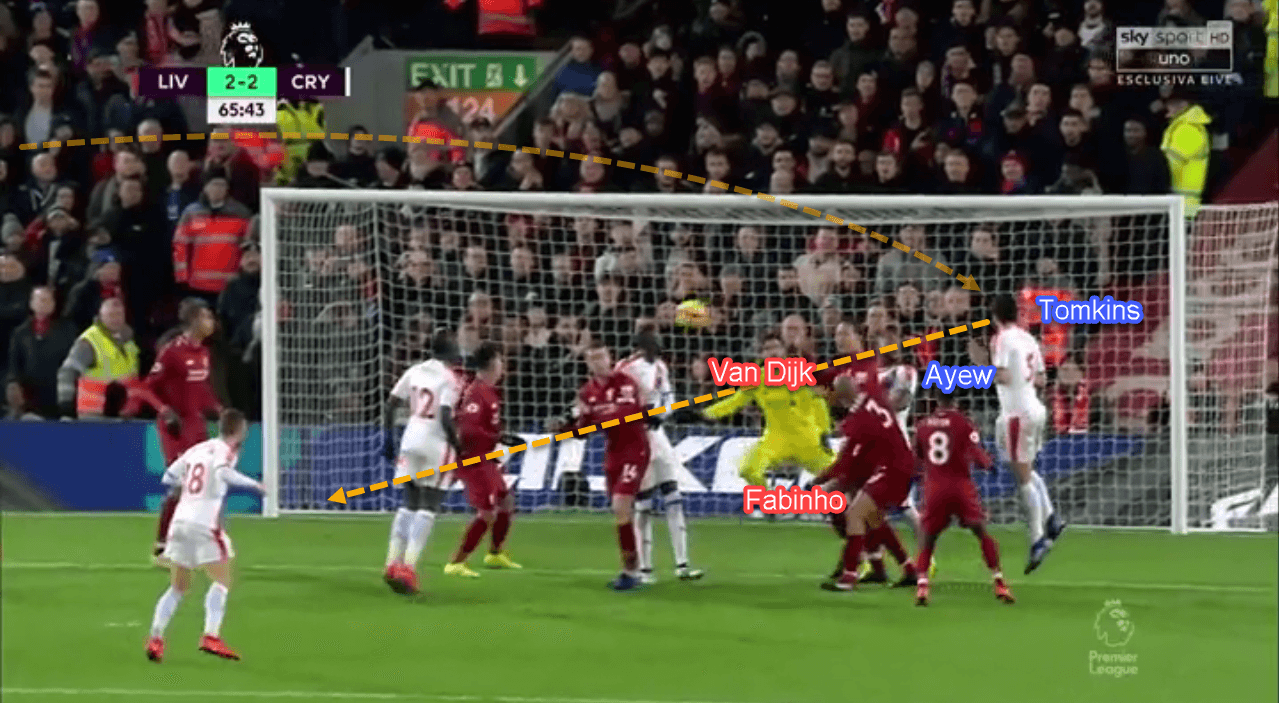
Lucky Liverpool? (Part two)
Liverpool didn’t change their approach to open up Palace’ 4–5–1 low block. They utilised their full-backs on both flanks to receive diagonal passes from the midfield, before sending the ball into the box. On one occasion, Fabinho successfully found Milner at the far post with a pass over the top. Milner then tried to send the ball into the goalmouth with his first touch.
Speroni was aware and came out to collect the ball. Somehow he miscalculated his movement and tipped the ball into his own net. Salah, who was Milner’ actual target, arrived on the goal line to poke the ball in to bag his 50th Premier League goal, and restore Liverpool’s advantage.
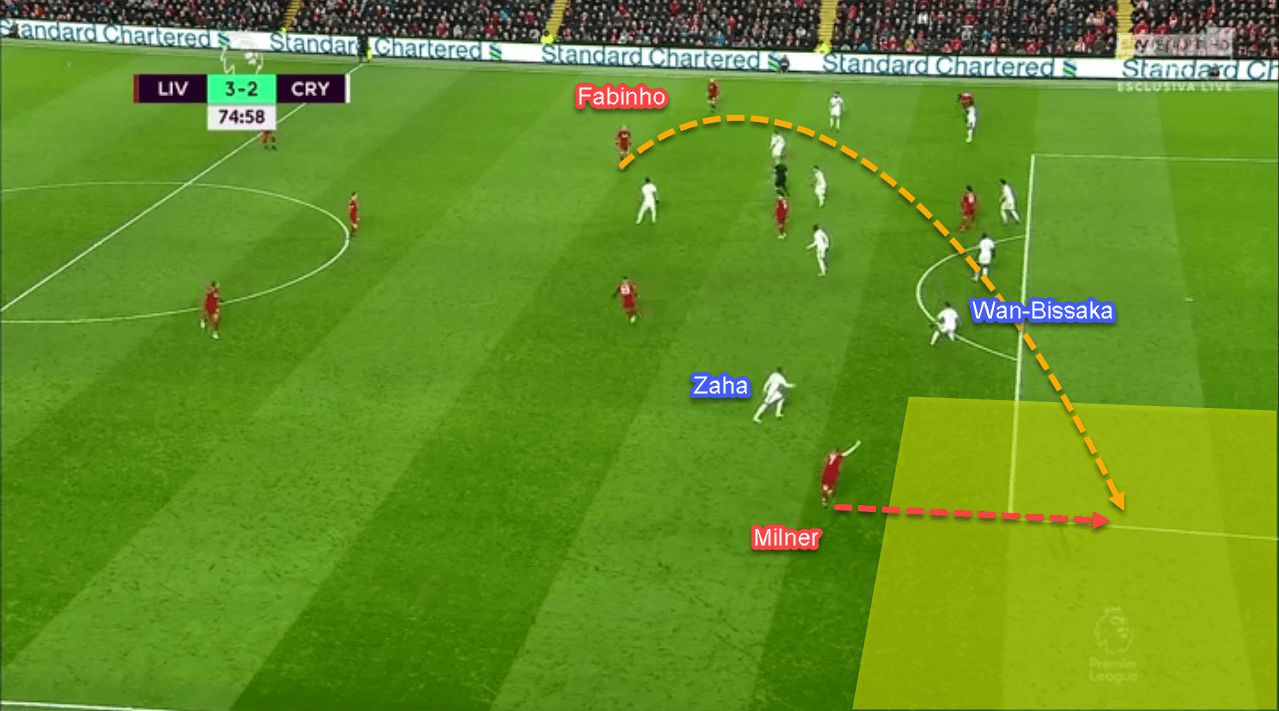
Hodgson’ late adjustments
In the last 15 minutes, Palace left their low 4–5–1 block and started to apply more aggression up front. Hodgson changed his team’ shape into a 4–3–3 offensively, with Connor Wickham as their target-man. They tried to utilise Wickham’ strength and aerial ability by sending long balls from deep to him in order to bring the ball forward quicker.
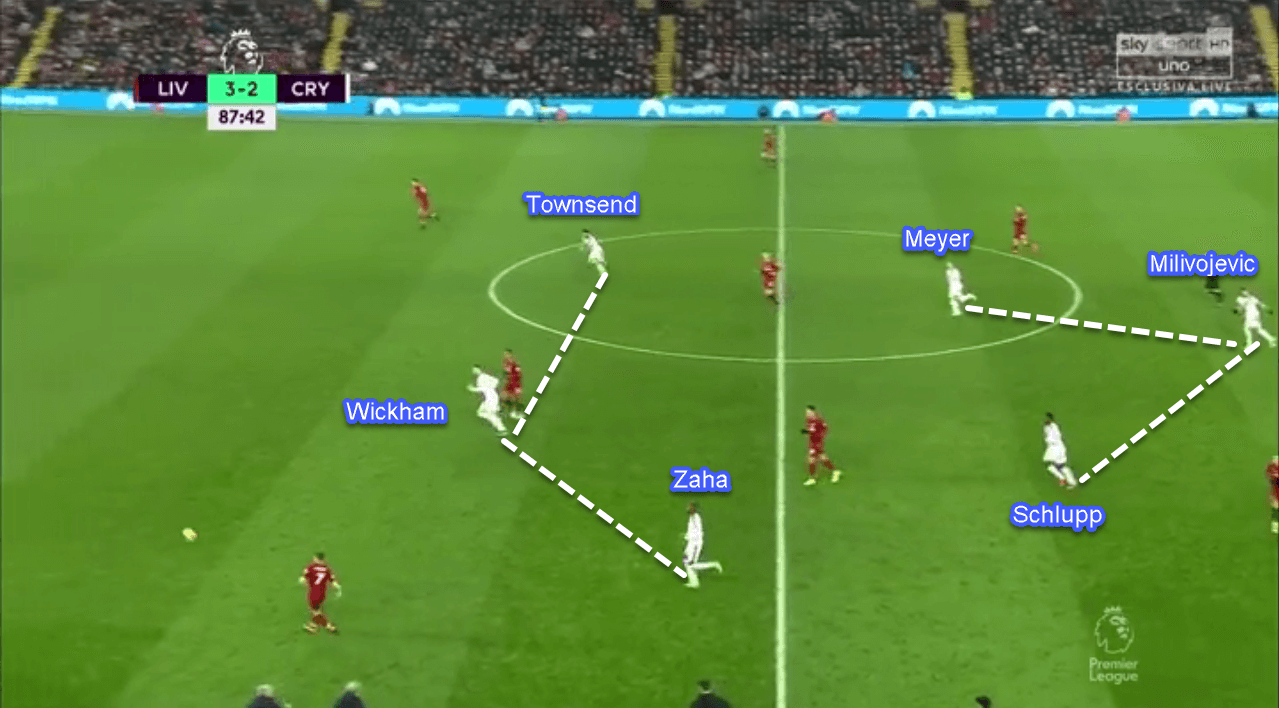
Liverpool had tried to exploit between the lines. What happened in the last quarter of an hour was the opposite. In the 4–3–3, there were huge gaps between the defensive line and the midfield line. This happened because Hodgson allowed his midfielders to roam forward and press the home side far into their box while providing almost no cover for their defence.
This gap was very visible, especially when Liverpool were trying to make their counter-attacks. As we know, Liverpool have very pacy forwards who excel in the transition game. They happily exploited any spaces with their deadly pace and supreme dribbling ability, even late in the game. One of their counter-attack attempts actually ended in a goal with Mane’s 93rd-minute strike.
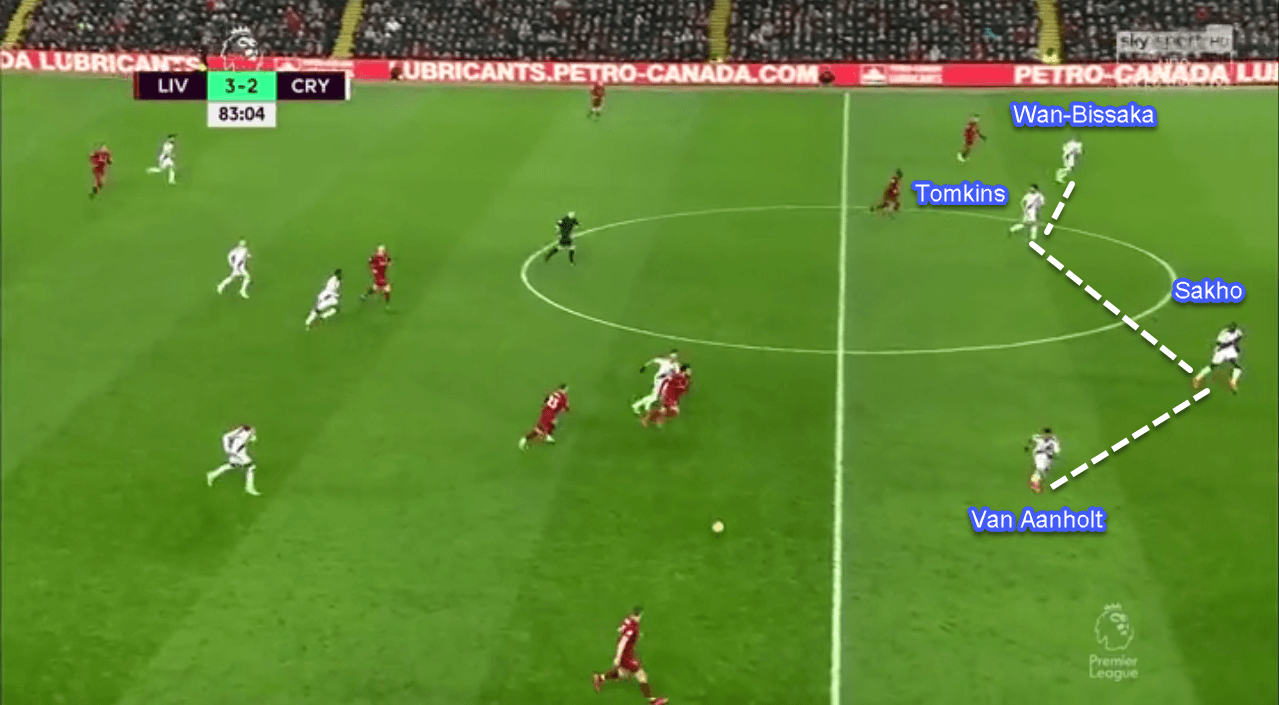
Conclusion
Zaha bullied Milner throughout the night and the latter was red-carded just before normal time ended. Hodgson’ defensive 4–5–1 worked brilliantly for more than 75 minutes. The away side even got a third goal in the last minute of the game via Max Meyer’s strike. It was a great performance from Crystal Palace, and in truth the result didn’t give them what they deserved. They should have left Anfield with at least a point following an amazing display.
To say that Liverpool’s win was purely down to luck is not appropriate. Yes, there were deflections and even a blunder to help them score, but we have to appreciate their patience to unlock Palace’s low block for almost 90 minutes. At the end of the day, moments of individual brilliance from Salah, Firmino, and Mane gave Liverpool their much-needed win. This victory definitely boosted Liverpool’s confidence ahead of their game against Leicester City next gameweek.
After all, it was a cracking game and both teams did their best to give us great entertainment. Now, with 15 matches left, the question remains whether Liverpool can hang on and win their first-ever Premier League title.
If you love tactical analysis, then you’ll love the digital magazines from totalfootballanalysis.com – a guaranteed 100+ pages of pure tactical analysis covering topics from the Premier League, Serie A, La Liga, Bundesliga and many, many more. Buy your copy of the January issue for just ₤4.99 here, or even better sign up for a ₤50 annual membership (12 monthly issues plus the annual review) right here.

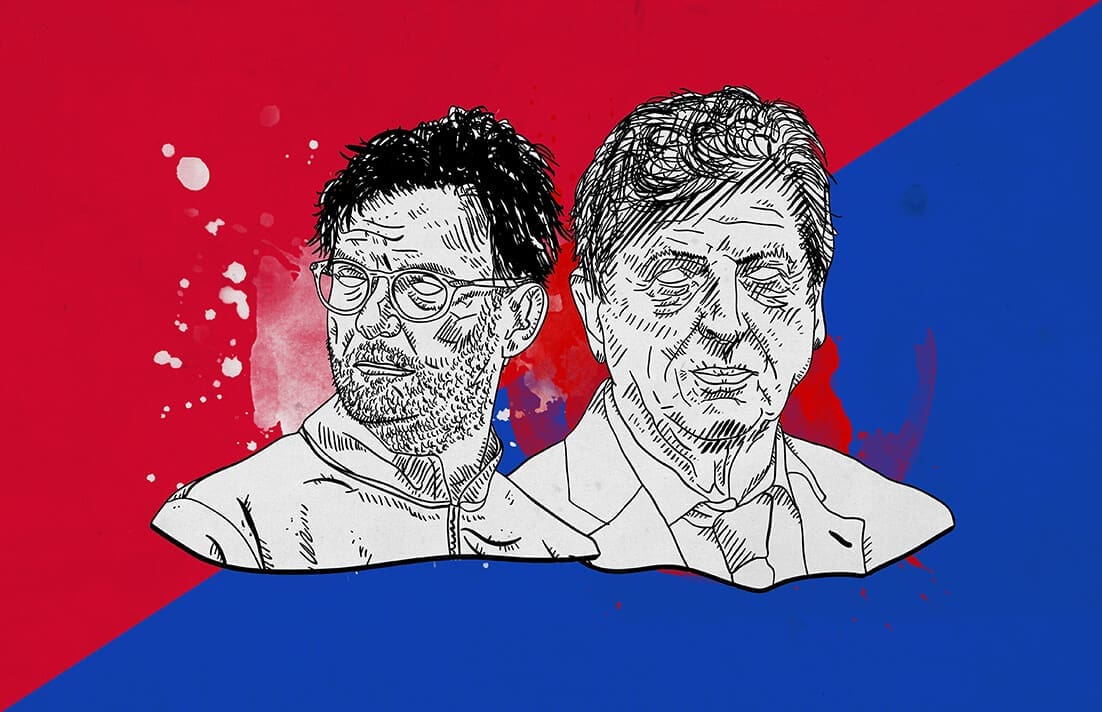


Comments